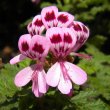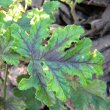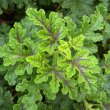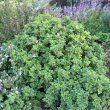| Botanical Name |
Pelargonium quercifolium variety |
| Family |
Geraniaceae - The geranium family. |
| Pronunciation |
pe-lar-GO-nee-um kwer-sih-FOE-lee-um |
| Common Name(s) |
English: Oak-leaved pelargonium
|
| Plant Group |
- Perennial A plant whose life cycle lasts for three or more seasons.
- Shrub A woody plant of relatively low height, having several stems arising from the base and lacking a single trunk; a bush.
|
| Plant Size |
- Medium
| Tree | 10m to 16m |
| Shrub | 1m to 2m |
| Perennial/ground cover | 40cm to 60cm |
| Bulb | 40cm to 60cm |
| Succulent | 40cm to 60cm |
|
| Position |
- Partial Shade The area is in shade for part of the day and in full sun for part of the day.
- Sun The area is in full sun for all or most of the day, all year round.
|
| General Information |
- Drought Tolerance: High The plant is well adapted to arid conditions; it can survive long periods of drought and high temperatures without extra water.
- Evergreen Plants that have leaves all year round.
- Fragrant / Aromatic These plants posses a strong, usually pleasant odour.
- Frost: Half-hardy The plant is able to survive low temperatures and some frost but requires protection against severe frost.
- Prune hard after flowering Fast growing shrubs that grow lanky within a season. Cut off branches and stems of these plants to a third of their original length. This will increase the yield of flowers, improve the plants shape and enhance the structural strength of main branches.
- Water Wise Plant species originating from low rainfall regions that require less water to survive and thrive than other plant species.
|
| Specific Information |
Pelargonium quercifolium (variety) is an erect, branched shrub with oak-like foliage with a strong scent of balm. This variety is categorised as Pelargonium quercifolium, the differences being the dark purplish-maroon colour of the central veins of the leaves and the slightly larger flowers. It appears to be particularly resistant to disease and insect pests. The young stems of pelargoniums are green and soft but become woody when mature.
|
| Ad Break |
|
| Flowers |
| Description |
two upper petals with dark purplish-red markings and three lower petals, unmarked
|
| Season |
- All Year Plants will seldom bloom for the entire season as given in the list, but should flower during a period within these parameters.
- Spring to Summer Plants will seldom bloom for the entire season as given in the list, but should flower during a period within these parameters.
|
| Colour |
|
| Growth Rate |
- Moderate to Fast Specifying growth rate can be very misleading as there is considerable variation of growth rate depending on type and species of plant, available water, supplementary feeding, mulching and general care, as well as the plants suitability and adaptability to the garden environment.
|
| Plant Uses |
- Accent or Focal Point A plant used to attract the attention because of its colour or form.
- Attracts bees, butterflies or other insects This plant attracts insects which can be food for birds or other creatures in your garden.
- Border A strip of ground, at the edge of a driveway or path in which ornamental plants or shrubs are planted.
- Boundary A plant useful for planting around the edges of the property to form a green or colourful backdrop, an impenetrable hedge, to hide walls or create privacy.
- Container Trees, shrubs and ornamental species that can adapt to growing in a restricted environment.
- Filler Either a fast growing tree or shrub used temporarily to fill in an area while the permanent plants grow to a desired size, or a plant used to fill gaps in borders or beds.
- Pioneer for new gardens A very fast growing plant, able to withstand hardship, that can be used to populate land that has recently been cleared of natural vegetation. These plants pave the way for slower-growing species by adding nutrients to the soil and creating leaf litter.
- Rock Garden An area constructed of larger rocks, arranged naturally, to emphasise the use of stones as a main element. Generally plants used do not need a lot of care.
- Screen A tall hedge of suitable plants planted closely together and used as a windbreak, to block a bad view, to separate parts of the garden or as a backdrop.
- Suitable for coastal gardens Plants adapted to dry, sandy soil, forceful wind, limited rainfall and intense sunlight.
- Suitable for smaller gardens Such plants do not have invasive root systems, remain small or controllable and can often be grown in containers.
- Wild Garden An indigenous garden planted for the benefit of wildlife and birds. Provides food, water, a variety of mini-biomes and no poisonous chemicals are used.
|
| Distribution and Habitat |
limited to areas in the vicinity of the Western Cape towns of Oudtshoorn and Willowmore, in karoid, or fynbos vegetation, on rocky sandstone, shale or limestone
|
| Planting Suggestions |
Pelargonium quercifolium is easy to grow as it adapts to almost any environment. It grows naturally in rather dry conditions. Do not over water or over feed as the stems grow long and heavy, resulting in breakage of the somewhat brittle older growth. Compost can be added to the soil if needed and a good layer of mulch should be laid around the plant. Water until established then reduce the amount of water so that the plant becomes truly water wise. To encourage bushing, break off the tips of young shoots. It is advisable to cut back hard after flowering at least for the first two seasons, after which lighter pruning should be sufficient, depending on how large a shrub you want. I have found that severe pruning in the earlier years creates a stronger base structure.
|
| Medicinal Uses |
Traditionally taken internally for the treatment of rheumatism, hypertension and heart disease. The plant is an aromatic, stimulant herb with a resinous scent and of which all parts are astringent. Essential oils are obtained from the leaves. The leaves can also be used fresh in infusions.
|
| Ad Break |
|








Comments
Seeds for snake repellant flowers
can you mail me a quotation of a variety of snake repellent flowers.
Snake repellent plants
Hi Witker
The only plants I have come across that are mentioned as 'snake repellent' are Tulbaghia violacea (Wild garlic), Plectranthus neochilus (Lobster flower) and Pelargonium quercifolium (Muishondbos). The information comes by word of mouth from traditional healers some time in the past century or two. There are no studies or literature backing up these claims and the use of these plants seems limited to small areas. I have in fact found a nice sized Puff adder lurking in my Wild garlic, so I am a bit cautious about the efficiency of these plants.
I can supply these plants if you wish. Please email me: kumbulanursery@gmail.com for details.
Kind regards
Lorraine
Pelargonium leaf with red veins?
thanks to your wonderful website I've IDed a pelargonium cutting I was given. Pelargonium leaf red veins - to Google - and here I land.
Welcome
Hi Diana
Glad you found us. I love this particular pelargonium because it is so compact and needs only a little pinching back every now and then. Many of the other pelargoniums in my garden have to be replanted every second year because of rust but this one is almost immune.
Hope your cutting grows well.
Kind regards
Lorraine
Discuss this plant
Share knowledge, ask a question or give an experience.